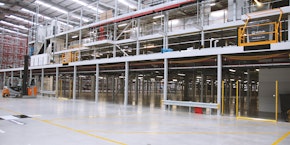Covid compliant intralogistics

The government has issued guidance on working safely during coronavirus (Covid-19), which highlights practical actions for businesses to take. These are based on five steps: carrying out a Covid-19 risk assessment; developing cleaning, hand washing and hygiene procedures; helping people to work from home where possible; maintaining 2-metre social distancing where possible; and managing the transmission risk where people cannot be 2-metres apart.
Of course, many logistics operations have already been carrying out these measures, as they continued diligently to operate throughout the lockdown to keep the country supplied, fed and healthy. More are set to join them in adhering to the recommended precautions, as we move cautiously into a still indeterminate business environment.
Safe picking
One thing remains certain: goods need to be picked in warehouses, but with the prime consideration of staff health. So the question is: what solutions are there to assist in keeping staff separate but still productive? These two requirements are not always mutually exclusive. Take for example live storage flow racks. They have a long established advantage of goods being replenished – often using forklift trucks – from the aisle behind the rack of flow lanes and picked – often by pedestrians – from the aisle in front.
Add a conveyor to the pick face and zones can be created to allow a picker to remain within a localised area, being responsible for picking items for an order in that zone before sending the order tote on the conveyor to the next zone. The density of storage provided by live systems allows a greater number of pick locations within a zone than would be possible with traditional racking. As one carton or pallet is emptied, it is removed for another to flow down the lane to take its place at the pick face – ensuring items are constantly available. In addition to keeping staff separate, live storage maximises their productivity, as pickers sticking to their zones need not waste time and energy traveling long distances during the day.
Driverless transport
Driverless transport devices can offer greater agility than a fixed conveyor when it comes to transferring goods from a pick zone. They can take over transport journeys from staff, allowing them to remain in the pick zones where they are most productive. BITO’s LEO Locative container transporter, for example, can link workstations located between pick zones, the Goods In area, dispatch or, if in a manufacturing plant, to the production lines. No expensive software is required; users simply lay down an adhesive coloured line on the facility floor to mark the route for LEO to follow. Stations where the transporter needs to stop and any tasks that must be performed at each location are also specified using markers applied directly to the floor.
The ease of set up means it can be completely managed in-house – keeping procurement costs low. The user is always in charge of specifying routes and stopping points for the transporter and can scale up simply by adding units when necessary, without committing to large initial capital expenditure.
Mezzanine floors
For some warehouses, keeping staff separate may require creating additional space. Mezzanine floors can offer a highly efficient and cost effective means of creating additional space, quite literally, out of thin air – where warehouse height allows.
A structural mezzanine floor with load capacities of up to 1000 kg per square metres can serve a variety of applications – such as office space, multi-tiered order picking or packing areas for multiple benches, to give people the room required for social distancing. Order picking operations accommodated on a mezzanine tend to be for non-palletised goods in bins and containers, often for small parts picking from space efficient shelving and carton live storage systems. Combining a mezzanine with carton flow storage and the integration of suitable conveying equipment, such as powered vertical conveyors or lifts, will certainly optimise warehouse space.
Mezzanine floor with integrated storage
A mezzanine can be further maximised by integrating it with a pallet racking structure. Here the mezzanine that could be used as a small parts picking area would simply abut a pallet rack that forms a wall along one side of the mezzanine floor. This pallet rack could comprise flow racks at ground level to serve the picking zone located beneath the mezzanine. Buffer pallet storage levels for the flow racks could be located at the top of the rack and accessed from the replenishment aisle. Shelving could be installed into the rack on the mezzanine floor level, allowing access by pickers. Anti-collapse wire mesh fencing would prevent any product falling from the rack.
The key virtue of this design is that it allows an entire lane of deep shelving for the mezzanine level without additional load to the mezzanine structure. This is an important advantage because reducing the amount of weight a mezzanine is required to support will reduce its cost. Mezzanines can be installed quickly, generally only taking only a week to install approximately 100 square metres of mezzanine, with relatively little impact on operations.
Check with your supplier
These are just a few suggestions on how to adapt your warehouse for operating safely and efficiently to operate in the new workplace normal. Clearly, all organisations are facing conditions that are far from ideal but it is important that we find innovative ways to adapt and function in whatever future scenario comes our way. Companies would be well advised to discuss with their storage supplier how their warehouse layout can be refined to adapt to these changing circumstances and ensure covid-compliance.